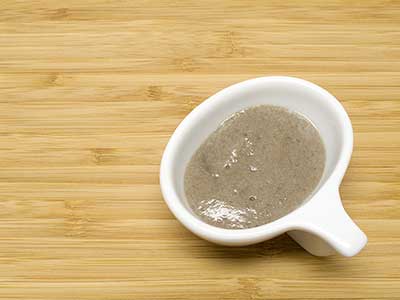January 6, 2014
Mignardise

pudding à la banane
(banana pudding)
Me: “Here’s a new mignardise to try.” Wife: “Looks like poi.” Me: “Doesn’t taste like poi.” Wife: “What is it?” Me: “Just try it.” Wife: “Should I use my fingers?” Me: “Maybe it’s poi!” When I looked at the little dish with the gray, sticky stuff in it, I thought, “Gee, it does look like poi.” It wasn’t.
When I pureed the banana for the previously posted pain de banane recipe, I had a thought, “Do bananas have enough starch in them to thicken when heated?” I thought about the pudding de maïs recipe from a year ago where the natural starch in corn juice was sufficient to thicken the juice into a warm pudding. A brief online research session inspired me to give the concept a try. There wouldn’t be much lost if the experiment failed: a bit of electricity, a few splashes of water, a dribble of dish soap, and ten minutes of time. I wondered if this would be more expensive than the 38 cents the two bananas cost.
From my research I knew that as bananas ripen, starch is converted to sugar. From personal experience, I knew that bananas were sweetest when there were many brown spots on their skins. Since I didn’t want to add additional sugar to my new pudding, I would use bananas with well-freckled skins and hope that sufficient starch would remain in the bananas.
In the banana bread recipe, I pureed the banana by forcing it through a sieve. This time, being inherently lazy, I decided to try a mini-food processor. With much patience and a bit of straining, the food processor finally worked. On the next attempt, I used the Vita-Mix, which worked best and took longer to wash than to puree.
The resulting puree is a thick liquid. The color is slightly darker than the solid banana unless an antioxidant is added. To cook the pudding, the liquefied banana is heated rapidly over high heat while whisking continuously. When the liquid starts to boil, remove it from the heat, and divide it between individual serving bowls to cool. The banana puree will almost triple in volume while cooking. After cooking, it becomes a dark gray, unless an antioxidant is added, and slightly sticky. In its gray form it does look like poi.
The starch in this banana pudding seems stable. Three days after cooking, there appeared to be no syneresis. This means that this banana pudding can be made in advance and refrigerated until it’s time to serve it.
I don’t find the grayish color that unappetizing, but if you would like a more natural banana color, add 0.5% ascorbic acid, by weight, to the blender or food processor when you pureed the banana. The color of the finished pudding will no longer be gray, as in the picture above, but it will still lack the banana color found in commercial puddings. I think I’ll stick with the faux poi.
© 2014 Peter Hertzmann. All rights reserved.
